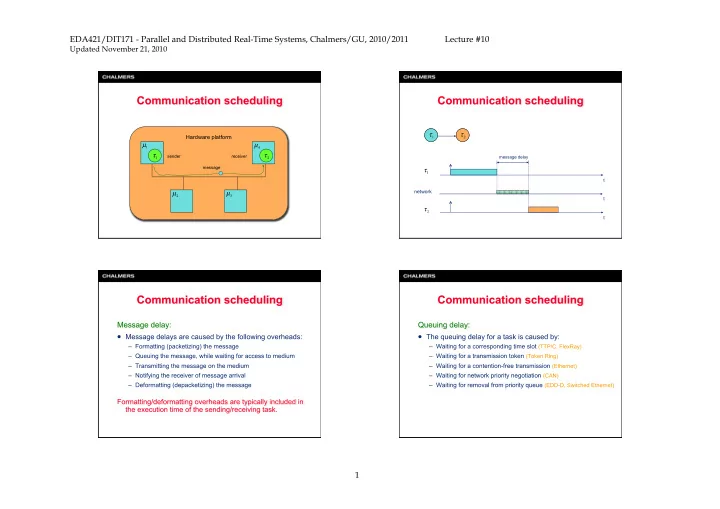

EDA421/DIT171 - Parallel and Distributed Real-Time Systems, Chalmers/GU, 2010/2011 Lecture #10 Updated November 21, 2010 T 1 T 2 Hardware platform sender receiver message delay message t network t t 1
EDA421/DIT171 - Parallel and Distributed Real-Time Systems, Chalmers/GU, 2010/2011 Lecture #10 Updated November 21, 2010 – Message length (bits) – Data rate (bits/s) and – Communication distance (m) – Signal propagation velocity (m/s) 2
EDA421/DIT171 - Parallel and Distributed Real-Time Systems, Chalmers/GU, 2010/2011 Lecture #10 Updated November 21, 2010 queuing delay transmission delay T 1 T 2 notification delay t network t t release jitter 3
EDA421/DIT171 - Parallel and Distributed Real-Time Systems, Chalmers/GU, 2010/2011 Lecture #10 Updated November 21, 2010 T 1 T 2 dedicated time slot t network t t 4
EDA421/DIT171 - Parallel and Distributed Real-Time Systems, Chalmers/GU, 2010/2011 Lecture #10 Updated November 21, 2010 ”Exclusive” – guaranteed service – Based on the CAN protocol Node ”Arbitration” – guaranteed service (high ID), best effort (low ID) A – Bus topology ”Reserved” – for future expansion... – Media: twisted pair CPU/ – 1Mbit/s mem/CC Transmission S S Columns S Basic cycle Node 3 0 Node 1 Node 6 Node 7 Basic cycle 1 Basic cycle 2 A second controller is Basic cycle required to implement the Node 5 3 redundant bus t Node 4 Node 2 Time is global and measured in network time units (NTU’s) – Double channels (one redundant). Bus topology or ”star” (optical) All communication is statically scheduled – Media: twisted pair, fibre Guaranteed service – 10 Mbit/s for each channel Node ”TDMA-round” Node 3 Node Node 1 A 6 ”message slots” CPU/ mem/CC Node Node Node 5 4 2 S S S Node Node 1 4 A Node Node t 2 5 B A network is built on either Node Node 3 6 twin buses or twin stars. Non-periodic messages have to be fitted into static slots by the application 5
EDA421/DIT171 - Parallel and Distributed Real-Time Systems, Chalmers/GU, 2010/2011 Lecture #10 Updated November 21, 2010 ”Static segment” (compare w/ TTCAN ”Exclusive”) – guaranteed service – Double channels, bus or star (even mixed). – Media: twisted pair, fibre ”Dynamic segment” (compare w/ TTCAN ”Arbitration”) Node – 10 Mbit/s for each channel – guaranteed service (high ID), ”best effort” (low ID) A CPU/ mem/CC 63 Node 3 62 Network Idle Time S S Node 1 Symbol window Node 6 Node 7 Guaranteed periodical Guaranteed ”Best-effort” S periodical/ aperiodical B aperiodical A 3 2 1 Node 5 0 Node Redundant channel can be Static segment Dynamic segment 4 Node 2 used for an alternative (m slots) (n mini-slots) schedule Max 64 nodes on a Flexray network. 6
EDA421/DIT171 - Parallel and Distributed Real-Time Systems, Chalmers/GU, 2010/2011 Lecture #10 Updated November 21, 2010 A necessary feasibility test: constantly rotating token A sufficient feasibility test: 1. Each node examines RRR of a busy token as it passes and PPP: priority field P P P P P P T M R R R R R R inserts the priority of its pending message only if it is RRR: reservation field greater than the priority currently in RRR. 2. A node does not grab a “free” token unless the priority of its pending message is at least as high as the priority in PPP. SD AC AC ED Then the token status is changed to “busy”. 3. A transmitting node appends its pending message after the Token format “busy” token and sets RRR appropriately. 4. A transmitting node waits until it receives back the “busy” SD AC AC ED addresses packet data error control ED FS token before releasing the next “free” token with PPP set to the (possibly) updated RRR. Message frame format 7
EDA421/DIT171 - Parallel and Distributed Real-Time Systems, Chalmers/GU, 2010/2011 Lecture #10 Updated November 21, 2010 A sufficient and necessary feasibility test: – Capture token when node has highest-priority message pending – Transmit message – Transmit subsequent free token collision-detect broadcast bus 8
EDA421/DIT171 - Parallel and Distributed Real-Time Systems, Chalmers/GU, 2010/2011 Lecture #10 Updated November 21, 2010 SOF 11-bit identifier control 0 - 8 bytes of message data error control Ack EOF 1. Each node with a pending message waits until bus is idle. 2. The node begins transmitting the highest-priority message pending on the node. Identifier is transmitted first, in the order of most-significant bit to least-significant bit. 3. If a node transmits a recessive bit (’1’) but sees a dominant bit (’0’) on the bus, then it stops transmitting since it is not transmitting the highest-priority message in the system. 4. The node that transmits the last bit of its identifier without detecting a bus inconsistency has the highest priority and can start transmitting the body of the message. 9
Recommend
More recommend